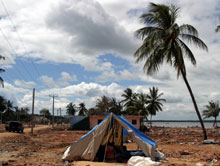|
Sri Lankan Tsunami Rehabilitation Plan Under Fire: Report
 |
|
President
Chandrika Bandaranaike laid the foundation stone of the new city
last week. (Reuters)
|
CAIRO,
January 24 (IslamOnline.net) – The Sri Lankan government’s plan
for reconstructing the tsunami-hit areas in the country drew heavy
criticism from the Muslim, Tamil and Singhalese communities, reported
a leading British newspaper on Monday, January 24.
The
plan is not only aiming at housing the some one million people left
homeless by the killer tidal waves but also providing an example of
integration among the three communities, said The Independent.
The
foundation stone of the new town, to be known as Siribopura, was laid
last week by Sri Lankan President Chandrika Bandaranaike in virgin
jungle territory two miles inland.
It
will house 6,000 families from the southern coastal town of Hambantota
who lost their homes to the tsunami, triggered by a 9.0 magnitude
undersea quake that struck deep in the Indian Ocean off the west coast
of Indonesia’s Sumatra Island.
According
to the plans, the town will be multi-ethnic, mixing Muslim, Tamil and
Singhalese communities in three-storey blocks of flats, said The
Independent.
It
will also contain a “multi-ethnic religious center”, the first of
its kind to be built in the country.
In
theory, Siribopura will set the standard for the other 60 towns to be
built around the country.
Serious
Consequences
The
government’s plan triggered a wave of controversy and drew criticism
from almost all parties.
“There
will be serious social and culture differences which can't be
overcome,” said Gamini Jayaratne -- a local Singhalese with four
children – who lost his brother and sister to the tsunami.
“At
the moment we all live in harmony, but separately. In addition the new
settlement is right in the middle of a Singhalese-dominated area. You
can't suddenly move 10,000 Muslim people there.”
Even
local officials seemed to ridicule the plan.
“People
don't want to live on top of each other. We're used to having our own
homes with gardens. You just have to look at Colombo to see the social
consequences of living in flats,” said Nisam Shyiam, a local
government planning officer.
He
charged that the move was another attempt by the government to save
money.
Furious
Muslims
 |
|
Sri
Lankan tsunami survivors rest at refugee camp in Hambantota.
(Reuters)
|
Beleaguered
Sri Lankan Muslims of Hambantota were equally furious.
The
government is now planning to demolish Hambantota's mosque, which
remarkably survived the tsunami, said The
Independent.
“This
is where we've always worshipped,” said one local Muslim who has
lived in the now destroyed village for 44 years.
“We
don't want that to change. The mosque is still there so we want to
live near by. It forms the center of our community.”
Mohammed
Khalid, 55, a local fisherman living in a tent near the beach, weighed
in describing the Siribopura idea as “absolutely ridiculous”.
“Everything
about it is wrong. It's going to turn into a slum within a year.
“We
really don't want to go but what choice do we have? What's annoyed us
the most is not once have we been asked how or where we want to
live.”
At
present, Khalid and his neighbors are living in donated tents.
He
told The Independent that on arriving in the area to lay the
foundation stone of the new town, President Bandaranaike went straight
to the new site and carefully avoided stopping off at the refugee
camps near the beach.
“If
she'd come down here, she'd only be met with fierce opposition.
Hambantota is supposed to be the flagship for the reconstruction of
this broken country. If the others are handled like this, it's going
to be a disaster.”
|